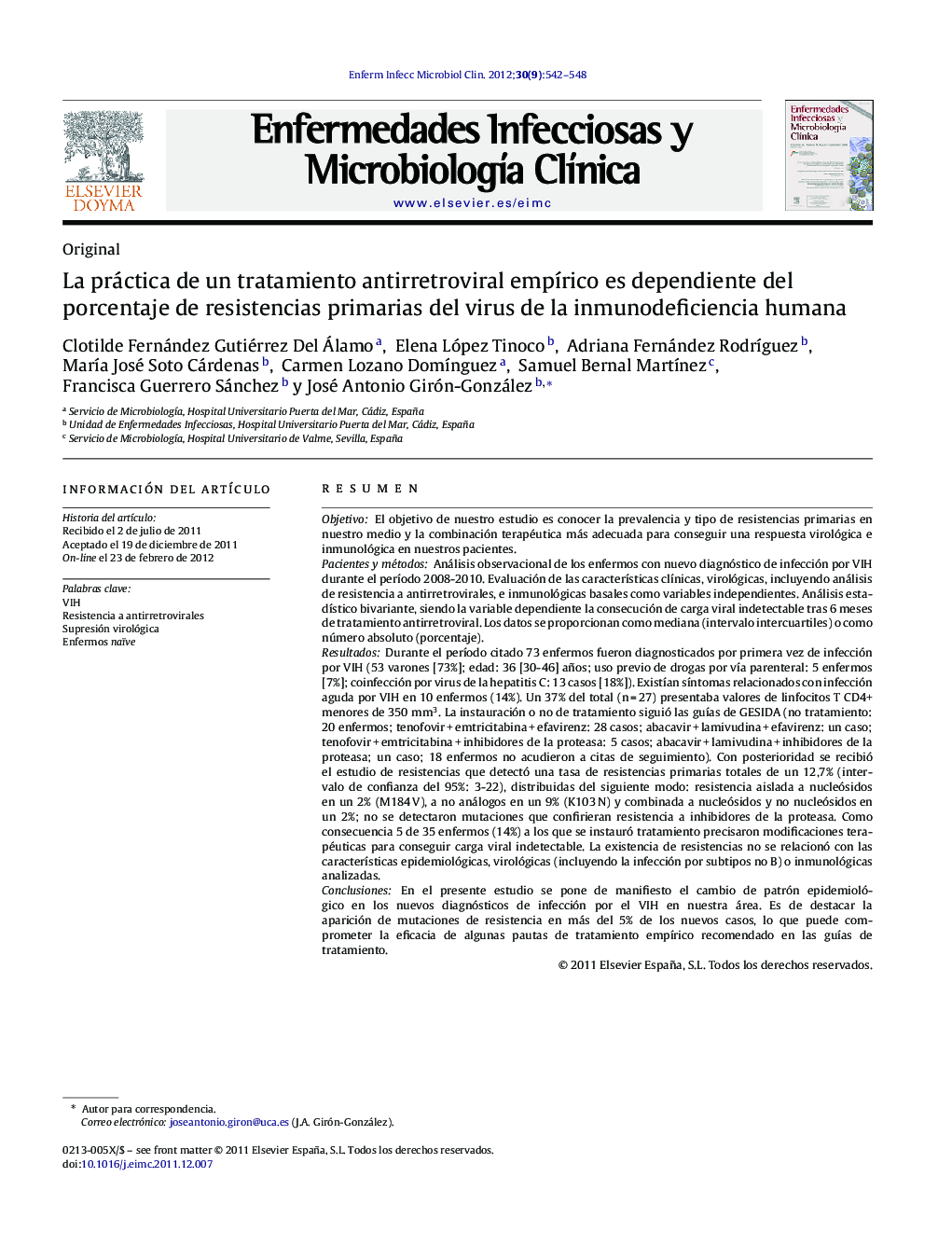| کد مقاله | کد نشریه | سال انتشار | مقاله انگلیسی | نسخه تمام متن |
|---|---|---|---|---|
| 3401347 | 1222660 | 2012 | 7 صفحه PDF | دانلود رایگان |

ResumenObjetivoEl objetivo de nuestro estudio es conocer la prevalencia y tipo de resistencias primarias en nuestro medio y la combinación terapéutica más adecuada para conseguir una respuesta virológica e inmunológica en nuestros pacientes.Pacientes y métodosAnálisis observacional de los enfermos con nuevo diagnóstico de infección por VIH durante el período 2008-2010. Evaluación de las características clínicas, virológicas, incluyendo análisis de resistencia a antirretrovirales, e inmunológicas basales como variables independientes. Análisis estadístico bivariante, siendo la variable dependiente la consecución de carga viral indetectable tras 6 meses de tratamiento antirretroviral. Los datos se proporcionan como mediana (intervalo intercuartiles) o como número absoluto (porcentaje).ResultadosDurante el período citado 73 enfermos fueron diagnosticados por primera vez de infección por VIH (53 varones [73%]; edad: 36 [30-46] años; uso previo de drogas por vía parenteral: 5 enfermos [7%]; coinfección por virus de la hepatitis C: 13 casos [18%]). Existían síntomas relacionados con infección aguda por VIH en 10 enfermos (14%). Un 37% del total (n = 27) presentaba valores de linfocitos T CD4+ menores de 350 mm3. La instauración o no de tratamiento siguió las guías de GESIDA (no tratamiento: 20 enfermos; tenofovir + emtricitabina + efavirenz: 28 casos; abacavir + lamivudina + efavirenz: un caso; tenofovir + emtricitabina + inhibidores de la proteasa: 5 casos; abacavir + lamivudina + inhibidores de la proteasa; un caso; 18 enfermos no acudieron a citas de seguimiento). Con posterioridad se recibió el estudio de resistencias que detectó una tasa de resistencias primarias totales de un 12,7% (intervalo de confianza del 95%: 3-22), distribuidas del siguiente modo: resistencia aislada a nucleósidos en un 2% (M184 V), a no análogos en un 9% (K103 N) y combinada a nucleósidos y no nucleósidos en un 2%; no se detectaron mutaciones que confirieran resistencia a inhibidores de la proteasa. Como consecuencia 5 de 35 enfermos (14%) a los que se instauró tratamiento precisaron modificaciones terapéuticas para conseguir carga viral indetectable. La existencia de resistencias no se relacionó con las características epidemiológicas, virológicas (incluyendo la infección por subtipos no B) o inmunológicas analizadas.ConclusionesEn el presente estudio se pone de manifiesto el cambio de patrón epidemiológico en los nuevos diagnósticos de infección por el VIH en nuestra área. Es de destacar la aparición de mutaciones de resistencia en más del 5% de los nuevos casos, lo que puede comprometer la eficacia de algunas pautas de tratamiento empírico recomendado en las guías de tratamiento.
ObjectiveThe objective of this study was the analysis of the prevalence and type of primary resistance to antiretroviral drugs in patients diagnosed with HIV infection, and to determine the most appropriate empirical treatment to obtain a virological and immunological response.Patients and methodsAn observational analysis of patients with a de novo diagnosis of HIV infection during the period 2008-2010. Clinical, immunological and virological characteristics, including genotype analysis of resistance to antiretrovirals, were considered as independent variables. The dependent variable was an undetectable HIV viral load after six months of treatment. Data are provided as median (interquartile range) and absolute number (percentage).ResultsSeventy-three patients with a de novo diagnosis of HIV infection were included [53 males (73%); 36 (30-46) years-old; prior use of intravenous drugs: 5 patients (7%); hepatitis C virus co-infection: 13 individuals (18%)]. Ten patients (14%) showed symptoms attributable to acute HIV infection. A CD4+ T cell count lower than 350 mm3 was detected in a 37% (n = 27) of all patients. The initiation of antiretroviral therapy followed the GESIDA recommendations (no therapy: 20 patients; tenofovir + emtricitabine + efavirenz: 28 patients; abacavir + lamivudine + efavirenz: 1 patient; tenofovir + emtricitabine + protease inhibitors: 5 patients; abacavir + lamivudine + protease inhibitors: 1 patient; 18 patients were lost in the follow-up). After starting antiretroviral therapy, the resistance analyses detected the existence of primary resistance to antiretrovirals in 12.7% (confidence interval 95%: 3-22) of the patients, distributed as follows: isolated resistance to, nucleosides was detected in 2% (M184 V), to nevirapine/efavirenz in 9% (K103 N), and combined resistance to nucleosides and non-nucleosides in 2%; there were no cases of resistance to protease inhibitors. Consequently, antiretroviral therapy was changed in 5 (14%) out of 35 patients, attaining an undetectable HIV viral load at 6 months in all of them. The primary resistance to antiretrovirals was not related with epidemiological, virological (including infection by non B subtype) or immunological variables.ConclusionsIn the present study, a change in the epidemiological pattern of de novo diagnosis of HIV infection in our area has been observed. The existence of resistance mutations in more than 5% of the new cases is noteworthy. This finding must be considered in order to establish the rules of empirical treatment in our area.
Journal: Enfermedades Infecciosas y Microbiología Clínica - Volume 30, Issue 9, November 2012, Pages 542–548